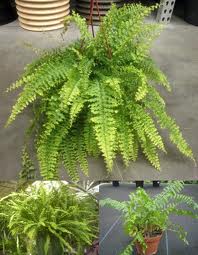|
These are Ferns that are found wild in many tropical areas, including Africa, America, Malaya and the West Indies. Nephrolepis is a small group, but contains many beautiful kinds that are well adapted for growing in pots in the greenhouse or home. The most popular are the varieties of N. exaltata, a plant that grows wild from Florida southward into Brazil and in Africa and eastern Asia. This Fern produces fronds, 3-5 feet in length and 2-6 inches wide. They have stiff midribs that are covered with fine brown hairs and the leaflets (pinnae), which are about half an inch wide, are set closely along each side of the midrib. There are many pretty varieties of N. exaltata. One well-known kind is N. exaltata bostoniensis, the Boston Fern, which has long, graceful, drooping fronds. The fronds of N. exaltata Piersoni, N. exaltata Piersoni improved and N. exaltata massii are bipinnate--that is, each of the little leaflets is divided into segments, giving it a feathery look. Some fronds are tripinnate, which gives them more of a fine, feathery look than the bipinnate kinds. These Ferns need a minimum temperature of 55-60 degrees and a fairly humid atmosphere.
Pot Cultivation
The best soil mixture for them is three parts of loam and one part of leaf mold or peat moss with a liberal amount of a combination of sand and crushed charcoal. Repotting should be done in February or March as soon as new growth begins. The plants are taken out of their pots, the crocks and all loose soil are removed from the roots and the plants are repotted into slightly larger pots. After potting, the soil should be thoroughly watered to settle it, but for some time afterwards care must be taken not to over water. When the soil is thoroughly filled with roots they may be watered freely. They should be shaded from sunlight until they're established and then exposed to full light, but protected from strong sunshine. Once the plants are established, weekly or biweekly doses of weak liquid fertilizers should be given. In greenhouses, a humid atmosphere should be maintained. Young plants may need to be repotted more than once a year. In addition to being transplanted in late winter, they will most likely benefit from being moved into larger pots around midsummer. The summer potting should be completed without disturbing the soil or roots more than is absolutely necessary. Treatment after potting is the same as for potting in late winter. N. exaltata and its varieties are great for growing in hanging baskets. As they mature, the fronds drape over the sides of the basket forming splendid balls of foliage. After being lined with moss, the baskets are half-filled with soil and well-rooted plants are set in the center. They are then filled in with soil, which is pressed fairly firm. They are thoroughly watered and hung up in a warm, humid greenhouse. When they are established, they are used for decorating the greenhouse or suspending under a porch outside in the summer. Plants in baskets need constant attention; the soil must not be allowed to dry out because the fronds will turn yellow and wither. The best method is to immerse them in a pail of water for a few minutes and hang them up in a spot where they can drip before hanging them in their usual position.
Propagation
These plants are easily increased by runners, which are formed abundantly by most kinds and by division. Spores are another way to produce more Ferns, but are rarely used because the other ways are much easier and more dependable. The spores can be sown as soon as they are ripe in the summer, or they can be stored in seed packets and sown at a later date. Young rooted plants that are formed on runners may be taken from old plants in the spring and potted individually in a sandy, peaty soil mixture in small pots. They should be kept in a humid atmosphere with a temperature of 60-70 degrees until they are well established. Most of the Nephrolepis with crested and plumose fronds are propagated by runners, as they don't produce fertile spores and vegetative reproduction is necessary to preserve their special features. There are several methods of obtaining rooted layers. The easiest is to fill a number of 3-inch pots with compost and arrange them around the old plant. The tips of the runners are pressed down into the small pots and when enough roots have formed, they're detached and treated as separate plants. Those kinds that don't produce spores or runners can be propagated by division, which can be carried out at repotting time in late winter or spring. The more zealous, outer portions of the plants should be used for replanting, rather than the worn-out central parts. The plants are taken out of their pots, and the compost is removed with a pointed stick. They're divided with a sharp knife and each division, consisting of a portion of the rootstock with roots and fronds attached, is potted in a small pot.
 |
N. exaltata |
Varieties
- N. exaltata;
- N. exaltata bostoniensis (Boston Fern);
- N. exaltata bostoniensis compacta (Dwarf Boston Fern);
- N. exaltata Piersoni;
- N. exaltata Piersoni improved;
- N. exaltata Massii;
- N. exaltata elegantissima;
- N. exaltata elegantissima Trevillian;
- N. exaltata Whitmanii;
- N. exaltata Whitmanii compacta;
|